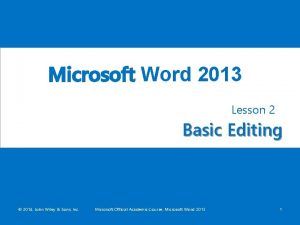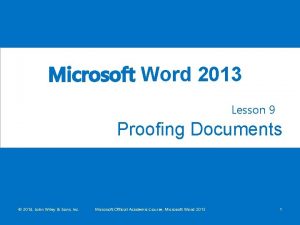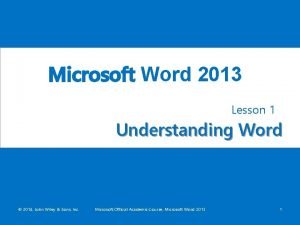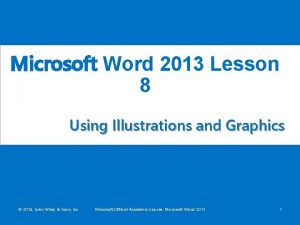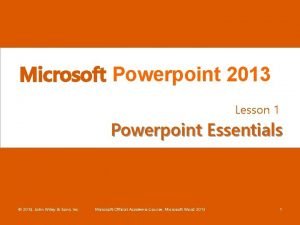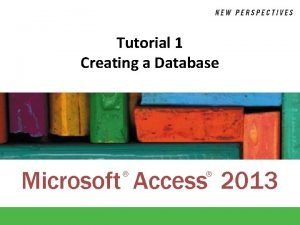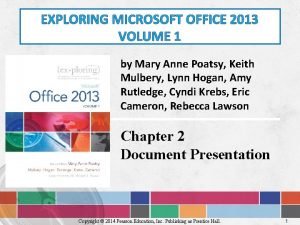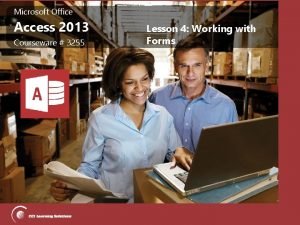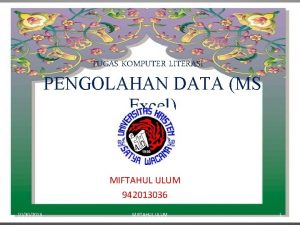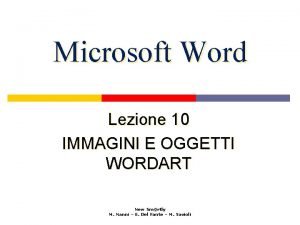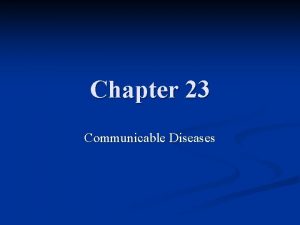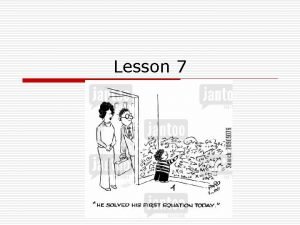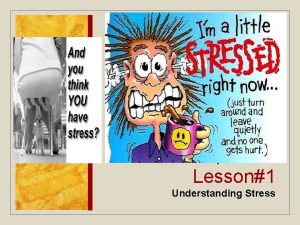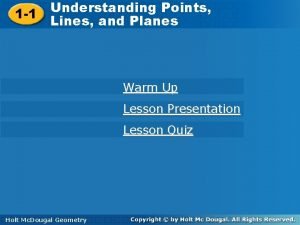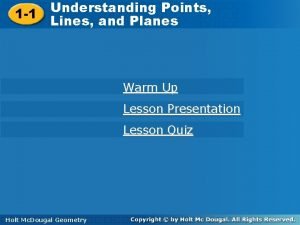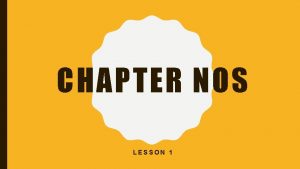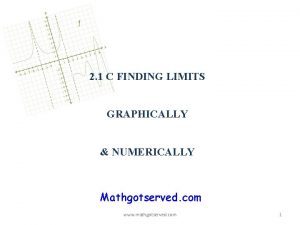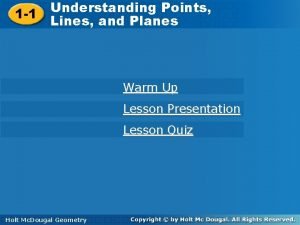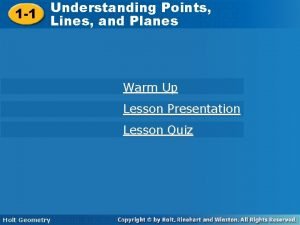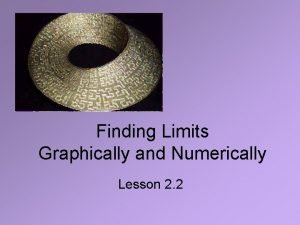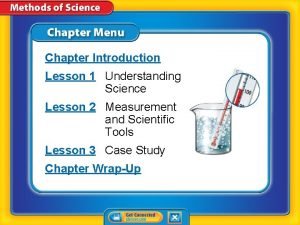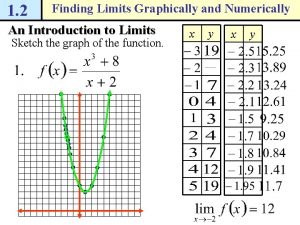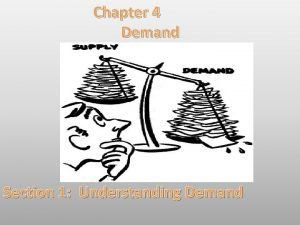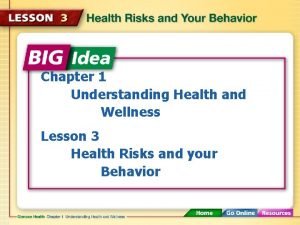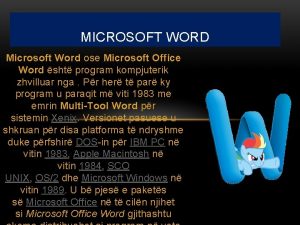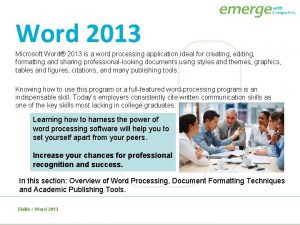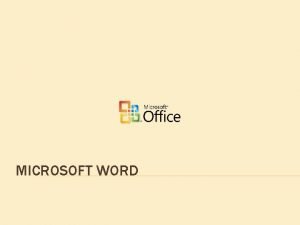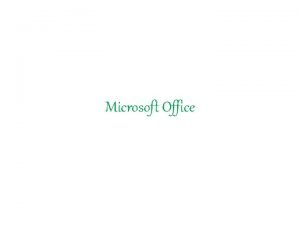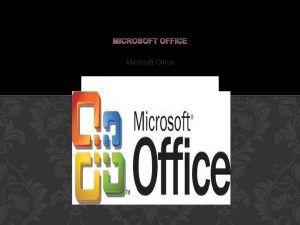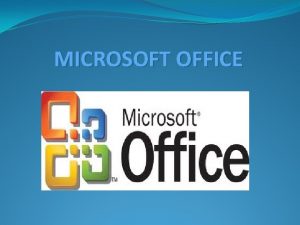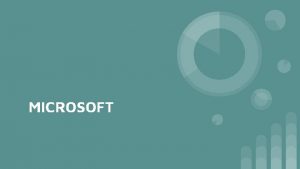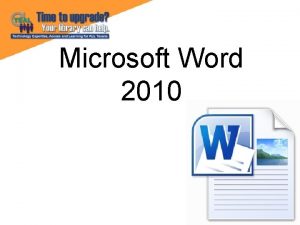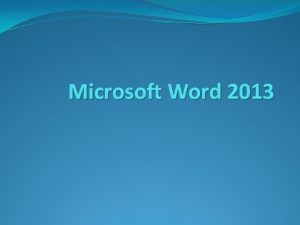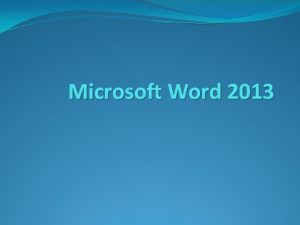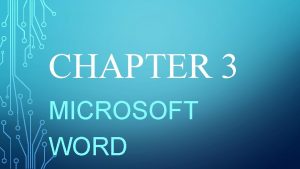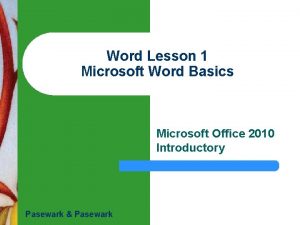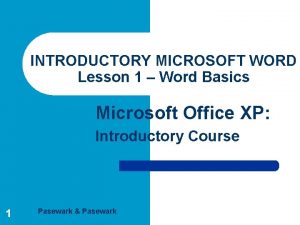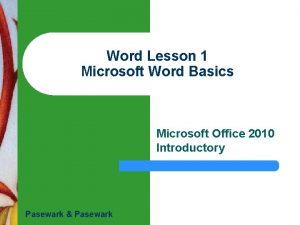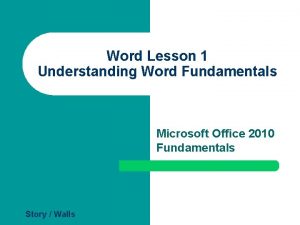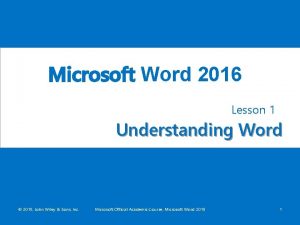Microsoft Word 2013 Lesson 1 Understanding Word 2014


































- Slides: 34

Microsoft Word 2013 Lesson 1 Understanding Word © 2014, John Wiley & Sons, Inc. Microsoft Official Academic Course, Microsoft Word 2013 1

Starting Word 2013 1. Microsoft Word is a word processing software used to create a variety of documents. 2. Word 2013 is similar to Word 2010 but with more enhanced features. a. New look for the Word icon b. Customized Office Background that appears above the Ribbon c. Live access to your One Drive account d. Option to work in Read Mode © 2014, John Wiley & Sons, Inc. Microsoft Official Academic Course, Microsoft Word 2013 2

1. When you first launch Word, it opens with the Recent screen displayed. You can either create a blank document or a document from a template. 2. When you exit a document and return later, Word 2013 resumes where you left off. © 2014, John Wiley & Sons, Inc. Microsoft Official Academic Course, Microsoft Word 2013 3

Software Orientation • Before you begin working in Microsoft Word 2013, you need to acquaint yourself with the primary user interface (UI). When Microsoft Word 2013 is opened, you see a screen similar to that shown below. © 2014, John Wiley & Sons, Inc. Microsoft Official Academic Course, Microsoft Word 2013 4

Step by Step: Start Word The new Word 2013 screen appears (below). On the left side of the screen, you see the recent documents that have been accessed, and the right side displays the blank document page and templates. © 2014, John Wiley & Sons, Inc. Microsoft Official Academic Course, Microsoft Word 2013 5

1. The Ribbon is located at the top of the Word screen. In your newly opened document, the Home tab is the default tab on the Ribbon, as shown below. Note how the Ribbon is divided into groups: Clipboard, Font, Paragraph, Styles, and Editing. 2. Review the other tabs on the Ribbon and review each group associated with the tab, and identify the arrow that launches the dialog box. © 2014, John Wiley & Sons, Inc. Microsoft Official Academic Course, Microsoft Word 2013 6

Use the Ribbon • Click the Page Layout tab to make it the active tab. Notice that the groups of commands change. The Page Layout tab contains three groups: Page Setup, Paragraph, and Arrange. • Notice that in the Page Setup and Paragraph group a small arrow appears in the lower-right corner. Clicking on the arrow opens the dialog box with more options to select or complete a command. • Click the Home tab. © 2014, John Wiley & Sons, Inc. Microsoft Official Academic Course, Microsoft Word 2013 7

Use the Ribbon • Click the dialog box launcher in the lower-right corner of the Font group. • The Font dialog box, as shown at right, appears. • The Font dialog box contains two tabs with the Font tab being the active tab. There are many options to select within the Font dialog box. Click Cancel to close the dialog box. © 2014, John Wiley & Sons, Inc. Microsoft Official Academic Course, Microsoft Word 2013 8

Use the Ribbon • Click the drop-down arrow on the Font command box in the Font group to produce a menu of available fonts, right. • Click the arrow again to close the menu. • Double-click the Home tab. Notice the command groups are hidden to give you more screen space to work on your document. • Double-click Home again to redisplay the groups. © 2014, John Wiley & Sons, Inc. Microsoft Official Academic Course, Microsoft Word 2013 9

Use the Mini Toolbar • • • When you type text into your document and drag the mouse pointer over a word(s), the mini toolbar appears. Notice the options you now have… Click the drop-down arrow on the Font command box. A font menu appears. Press Esc once or click the drop-down arrow again to exit the command box. To close the Mini toolbar, double-click the drop-down menu or click anywhere in a blank area within the document. © 2014, John Wiley & Sons, Inc. Microsoft Official Academic Course, Microsoft Word 2013 10

Use the Mini Toolbar • • If you position the insertion point on the selected text and right-click; the Mini toolbar appears, accompanied by a shortcut menu that displays a variety of commonly used commands (right). Click anywhere in a blank area of the document to close the Mini toolbar. Drag your mouse over the text you typed at the beginning of this exercise to select the text. Press the Delete key to remove the text. © 2014, John Wiley & Sons, Inc. Microsoft Official Academic Course, Microsoft Word 2013 11

Use the Quick Access Toolbar • • Click the Save button on the Quick Access Toolbar. If this is the first time you’ve attempted to save this document, the new Save As opens in Backstage. You have three options on where to save your work: • 1. One Drive • 2. Computer • 3. +Add a Place • For now, you are just exploring the Save command on the Quick Access Toolbar. Later in the lesson, you learn to save a document using the Save As command. © 2014, John Wiley & Sons, Inc. Microsoft Official Academic Course, Microsoft Word 2013 12

Use the Quick Access Toolbar • • Click the Return to Document icon, which is a circled left arrow located in the upper-left corner or press the ESC key to return to the document screen. Click the drop-down arrow at the Customize Quick Access Toolbar. A menu appears (right). Selecting one of the commands automatically places the command on the Quick Access Toolbar or moves the Quick Access Toolbar to a new location. © 2014, John Wiley & Sons, Inc. Microsoft Official Academic Course, Microsoft Word 2013 13

Use the Quick Access Toolbar • • Click Show Below the Ribbon. Notice that the toolbar is moved below the Ribbon. Click the drop-down arrow at the Customize Quick Access Toolbar button again. Click Show Above the Ribbon to return the toolbar to its original position. © 2014, John Wiley & Sons, Inc. Microsoft Official Academic Course, Microsoft Word 2013 14

Use Access Keys 1. 2. 3. 4. Click the Home tab. Press the Alt key. Key. Tips appears on the Ribbon and Quick Access Toolbar to let you know which key to use to access specific commands or tabs (below). Press H to activate the Home tab. Press PG to open the Paragraph dialog box, and then click Cancel. Press the Alt key again to display the Key. Tips. © 2014, John Wiley & Sons, Inc. Microsoft Official Academic Course, Microsoft Word 2013 15

Use Access Keys Continued • • • Press P to activate the Page Layout tab. Press O to display the options to change the page orientation. Press the Alt key twice to display the Key. Tips again, and then press the Alt key to turn them off. © 2014, John Wiley & Sons, Inc. Microsoft Official Academic Course, Microsoft Word 2013 16

Use Backstage View • Access Backstage by clicking the File tab. To return to your document screen, click the Return to Document icon circled left arrow or press the Esc key. © 2014, John Wiley & Sons, Inc. Microsoft Official Academic Course, Microsoft Word 2013 17

Use the Help Button • • Make sure you are connected to the Internet. Click the Microsoft Word Help button in the upperright corner of the screen or press F 1. The Word Help window appears, as shown below. © 2014, John Wiley & Sons, Inc. Microsoft Official Academic Course, Microsoft Word 2013 18

Display Nonprinting Characters • • • On the Home tab, in the Paragraph group, click the Show/Hide (¶) button to display the nonprinting characters in the document. Click the Show/Hide (¶) button again to hide the nonprinting characters. Press Ctrl+Shift+* to once again display the nonprinting characters. This time, leave Show/Hide on. © 2014, John Wiley & Sons, Inc. Microsoft Official Academic Course, Microsoft Word 2013 19

Hide White Spaces • • Make sure your insertion point is at the beginning of the document. Place the mouse below the Ribbon until you see the Screen. Tip Double-click to hide white space. Notice the gray border line representing the white space becoming thinner. Place the mouse between the gray border line until you see two arrows again and then double-click. This reveals the white space. © 2014, John Wiley & Sons, Inc. Microsoft Official Academic Course, Microsoft Word 2013 20

Use Auto. Complete • • Type the name of the current month; as you type the first four characters, a Screen. Tip appears. Press Enter to accept the suggested text. Press the Spacebar and the current day and year appears, and then press Enter. © 2014, John Wiley & Sons, Inc. Microsoft Official Academic Course, Microsoft Word 2013 21

Save a Document in a Folder 4. In the main pane of the dialog box, double-click the Word 2013 folder; notice the address bar displays your flash drive followed by Word 2013, as shown below. © 2014, John Wiley & Sons, Inc. Microsoft Official Academic Course, Microsoft Word 2013 22

Choose a Different File Format • • Click the File tab, and then click Save As to open the Save As screen. In the Save As type box, click the drop-down arrow and choose Word 97 -2003 Document (*. doc). You should see the. doc extension in the File name box—the file extension is associated with a previous version of Word. On the title bar, the file extension appears along with Compatibility Mode. In the next exercise, you learn about Compatibility Mode. File extension for Word 2013 is. docx File extension for Word 2013 TEMPLATE =. dotx © 2014, John Wiley & Sons, Inc. Microsoft Official Academic Course, Microsoft Word 2013 23

Convert a Document • • File tab. In the main pane of the Info command, click Convert, and then click OK to confirm the conversion, as shown below. Converting the document clears the Compatibility Mode on the title bar and upgrades your document to Word 2013 format, which allows you to access Word’s new features. © 2014, John Wiley & Sons, Inc. Microsoft Official Academic Course, Microsoft Word 2013 24

Export a Document to a PDF • Click the File tab and click Export command. The Export screen opens (see below). You use the Export command to share your documents with others. Publishing the document as a PDF file preserves the formatting. You can also select what you want to share before exporting. © 2014, John Wiley & Sons, Inc. Microsoft Official Academic Course, Microsoft Word 2013 25

Locate a Template Installed on Your Computer • Click the File tab, and then click New. The New screen displays the available templates as shown below. Scroll down and review the accessible templates. First determine what type of document needs to be created. © 2014, John Wiley & Sons, Inc. Microsoft Official Academic Course, Microsoft Word 2013 26

Find Templates on the Internet • • Click the File tab, and then click New. In the Search online templates box, type forms, and then click the Start Searching button. Additional templates are displayed as below. You can also filter the templates by category to narrow your search. Preview by using the scroll bar and select any template. Click Create. © 2014, John Wiley & Sons, Inc. Microsoft Official Academic Course, Microsoft Word 2013 27

Print Preview • Click the File tab, and then click Print. The Print screen opens with the Print options on the left and the Print Preview on the right, as shown below. © 2014, John Wiley & Sons, Inc. Microsoft Official Academic Course, Microsoft Word 2013 28

Use Print Preview • • Click the plus symbol (+) on the Zoom slider located on the bottom-right of your screen until the zoom level changes to 100%. Press the Return to Document icon or press the Esc key to close Backstage. © 2014, John Wiley & Sons, Inc. Microsoft Official Academic Course, Microsoft Word 2013 29

Choose a Printer • • Click the File tab, and then click Print. In the Printer selection area, click the drop-down arrow to produce a list of all printers connected to your computer (right). Select a printer, and then click the Print icon. Printer status is the area that Shows the available printers. © 2014, John Wiley & Sons, Inc. Microsoft Official Academic Course, Microsoft Word 2013 30

Set Print Options • • Click the File tab, and then click Print. Click the drop-down arrow on Print All Pages to produce the menu shown at right. © 2014, John Wiley & Sons, Inc. Microsoft Official Academic Course, Microsoft Word 2013 31

Close a Document and Close Word • Close Document: File and Close = closes document you have been working on but leaves Word running • Close Document using the Window icons (upper right had corner) = closes the document and closes Word • File and Exit = closes document and closes Word

• With any document you need to consider 1. Who your audience is 2. Type of document you need to use 2/24/2021 33

Templates • Predefined document that can be used repeatedly instead of redesigning each time. • If you are creating your own custom template and are planning to share the tempalte, be sure it is easy for others to use • Placeholder = where info should be typed. 2/24/2021 34
 Microsoft word 2014
Microsoft word 2014 Microsoft word 2014
Microsoft word 2014 Microsoft word 2014
Microsoft word 2014 Clip art microsoft word 2013
Clip art microsoft word 2013 Lesson outline lesson 1: understanding science answer key
Lesson outline lesson 1: understanding science answer key Microsoft official academic course microsoft word 2016
Microsoft official academic course microsoft word 2016 Microsoft official academic course microsoft word 2016
Microsoft official academic course microsoft word 2016 Microsoft powerpoint 2014
Microsoft powerpoint 2014 Microsoft access 2013 tutorial
Microsoft access 2013 tutorial Exploring microsoft office 2013 volume 1
Exploring microsoft office 2013 volume 1 Exploring microsoft office 2013 volume 1
Exploring microsoft office 2013 volume 1 Microsoft access 2013
Microsoft access 2013 Uraikan tentang efektivitas rumus pada microsoft excel 2013
Uraikan tentang efektivitas rumus pada microsoft excel 2013 Capolettera word
Capolettera word Chapter 9 lesson 3 understanding violence
Chapter 9 lesson 3 understanding violence Chapter 23 communicable diseases
Chapter 23 communicable diseases Lesson 7 understanding equations
Lesson 7 understanding equations Chapter 4 lesson 1 understanding stress
Chapter 4 lesson 1 understanding stress Lesson 4 promoting health and wellness
Lesson 4 promoting health and wellness Chapter 1 lesson 2 what affects your health
Chapter 1 lesson 2 what affects your health Chapter 1 lesson 2 what affects your health
Chapter 1 lesson 2 what affects your health Understanding points lines and planes
Understanding points lines and planes Lesson 1-1 understanding points lines and planes
Lesson 1-1 understanding points lines and planes Lesson 1-2 more geometric figures
Lesson 1-2 more geometric figures Understanding science lesson 1 answer key
Understanding science lesson 1 answer key Understanding limits graphically and numerically
Understanding limits graphically and numerically Understanding points lines and planes
Understanding points lines and planes Reteach understanding points, lines, and planes answer key
Reteach understanding points, lines, and planes answer key Lesson 2 understanding limits graphically and numerically
Lesson 2 understanding limits graphically and numerically Lesson 2 measurement and scientific tools answer key
Lesson 2 measurement and scientific tools answer key Finding limits graphically
Finding limits graphically Chapter 4 section 1 understanding demand
Chapter 4 section 1 understanding demand Chapter 23 lesson 1 understanding communicable diseases
Chapter 23 lesson 1 understanding communicable diseases Chapter 1 understanding health and wellness lesson 3
Chapter 1 understanding health and wellness lesson 3 Quran in word 2013
Quran in word 2013
